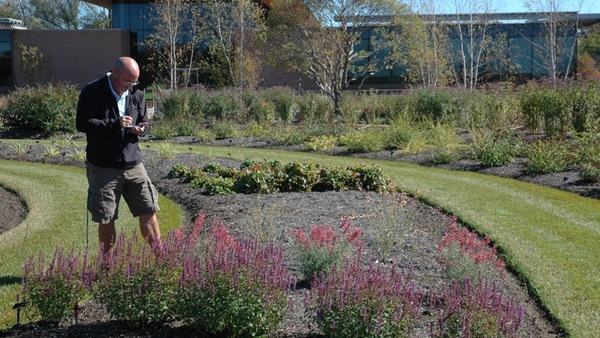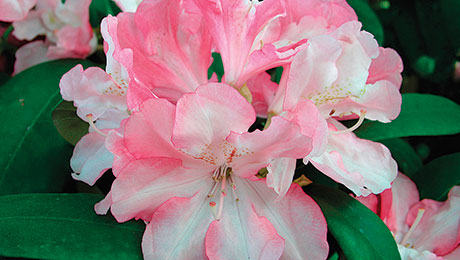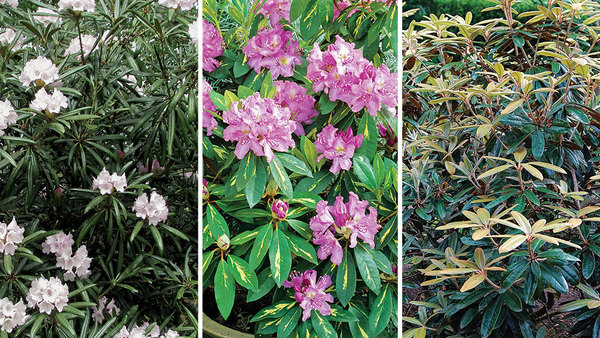
The Chicago Botanic Garden’s evaluation program has looked at nearly 10,000 different plants during the past 30 years, most of which were included in one of the more than a hundred comparative trials, both big and small, that we have done so far. If you have read my articles over the years, you know that comparative trials are the best way to measure one plant’s merits against those of other similar plants. But not every plant ends up in a comparative trial; stand-alone plants have become more common in our trials due to generous support from plant introduction programs and independent nurseries. Sometimes these single plants whet my appetite for more, which leads to a larger study. That was the case for gentians (Gentiana spp., Zones 3–9) and mountain hydrangeas (Hydrangea serrata cvs., Zones 6–9). Whether they are standalone plants or ones from an unreported comparative trial, think of the following plants as my “best of the rest”—a selection of outstanding perennials we’ve evaluated in recent years that for one reason or another haven’t made it onto the pages of Fine Gardening until now.
Trial ParametersUSDA Hardiness Zone: 5b How long: Minimum of four years Conditions: Full sun; well-drained, alkaline, clay-loam soil Care: We provided minimal care, allowing the plants to thrive or fail under natural conditions. In addition to observing their ornamental traits, we monitored the plants to see how well they grew and adapted to environmental and soil conditions while keeping a close eye on any disease or pest problems and assessing plant injury or losses over winter. |
Compact and Carefree Choices to Liven Up the Front of the Border
Long-lived and compact

‘Rosie Posie’ hyssop (Agastache ‘Rosie Posie’)
Zones: 5b–8
Size: 22 inches tall and 24 inches wide
Conditions: Full sun; average to dry, well-drained soil
Bloom period: Early summer to mid-autumn
Flower color and size: Purple-pink, 1 inch long
Overwintering hyssops has been challenging for us, which is the reason we’ve never done a large trial of them. Who needs that heartache? The blue- and purple-flowered varieties are pretty reliable, but it’s the ones that flower in shades of pink, red, orange, or yellow that taunt me. Imagine my delight when ‘Rosie Posie’ hyssop survived one winter, then another, and then another. Hot pink blossoms beautifully paired with dark magenta calyces create an intense floral show—and as with many mint relatives, the calyx holds its color long after the flower falls away. Nonstop from early summer into fall, scads of vibrant flowers are visited by hummingbirds and pollinators of all stripes. The bright green leaves are deliciously scented and disease free, and the ball-shaped habit stays compact throughout the summer. While ‘Rosie Posie’ thrived in full sun in our less than perfect soils, well-drained soils are recommended for hyssops to persist and look their best.
Looks great with almost anything

‘Millenium’ ornamental allium (Allium ‘Millenium’)
Zones: 5–9
Size: 20 inches tall and 13 inches wide
Conditions: Full sun; dry to average, well-drained soil
Bloom period: Early summer to early autumn
Flower color and size: Rose-purple, 1¾ inches wide
A few years ago on a suggestion, ‘Millenium’ ornamental allium—unknown to me at the time—was brought in to compare to ‘Summer Beauty’ and ‘Summer-Peek-A-Boo’. I didn’t know then that ‘Millenium’ was already widely praised by gardeners; eventually it was honored as Perennial Plant of the Year in 2018. ‘Millenium’—misspelling aside—is a phenomenal perennial with rosy purple midsummer flowers that float like lollipops above clumps of dark green, strappy leaves. The starburst-like seed heads hold up well for a long time before eventually crumbling. (Seedlings were not uncommon, so consider deadheading if that’s a worry.) Garden companions for stocky ‘Millenium’ are almost endless, but it mixed brilliantly with billowy calamint (Calamintha nepeta, Zones 5–7) in the trials. Both are pollinator way stations too.
Tidy and reliable

‘Paint the Town Magenta’ pinks (Dianthus ‘Paint the Town Magenta’)
Zones: 4–9
Size: 8 inches tall and 14 inches wide
Conditions: Full sun to partial shade; well-drained soil
Bloom period: Midspring to early summer (rebloom)
Flower color and size: Magenta, 1¼ inches wide
Like hyssops, pinks are often short-lived in our heavy soils, so growing them is almost a dare, but succeeding is a victory. On my continuing quest to find pinks that grow well for us, I was thrilled to discover ‘Paint the Town Magenta’, which is both pretty and super reliable. For over a month beginning in midspring, vibrant magenta flowers fully blanket the plants. When flowering ends and spent blossoms drop away neatly, attractive blue-green, pointy leaves are the backdrop for the smattering of flowers that pop up repeatedly into autumn. The low, mounded habit stays tidy at all times, never opening to show its crown or melting out in wet, humid weather. ‘Paint the Town Magenta’ has held its own for five years in our periodically wet site, but well-drained soils are best.
Repeat blooms with no deadheading

‘Azure Rush’ geranium (Geranium ‘Azure Rush’)
Zones: 5–9
Size: 14 inches tall and 39 inches wide
Conditions: Full sun to partial shade
Bloom period: Late spring to mid-autumn
Flower color and size: Light blue, 1½ inches wide
Rozanne geranium (Geranium ‘Gerwat’, Zones 5–8) took the gardening world by storm a while back, but now it is a sport of Rozanne that is getting some time in the sun. ‘Azure Rush’ embodies the greatest qualities of long-blooming Rozanne, but its lighter blue flowers with their ghostly eye are a charming distinction. Being sterile, ‘Azure Rush’ is dotted with flowers continuously from late spring to frost, and it doesn’t require deadheading to push repeat bloom. Both geraniums have aromatic dissected leaves and mounding habits, although shorter internodes on ‘Azure Rush’ mean that it rambles less than Rozanne and is more compact—14 inches tall and 39 inches wide, compared to 20 inches tall and 60 inches wide. ‘Azure Rush’ is adaptable to various light exposures in average soils, so it can easily bridge the transition zone between full sun and light shade in the landscape.
A stunning North American native

Indian pink (Spigelia marilandica)
Zones: 5–9
Size: 24 inches tall and 22 inches wide
Conditions: Full sun to light shade; average to moist, fertile, well-drained soil
Bloom period: Early summer to late summer
Flower color and size: Red and yellow, 2¼ inches long
Establishing the native Indian pink took multiple attempts, but it was well worth the pain of those losses once we succeeded. Exotically vivid red flowers, to 2 inches long, bloom in early summer and then again in late summer. From above, the flowers look like brilliant yellow stars, but from the side, their slender trumpet shape is evident. The whimsical flowers look like little soldiers lined up along the one-sided clusters. Indian pink keeps a fresh look all summer, with dark green leaves and a bushy clumping habit to 24 inches tall and wide. In sun or light shade, Indian pink likes moist, well-drained soils, and it will seed around once established; I was giddy when we discovered seedlings in 2019. This past spring, I added ‘Little Redhead’ (Spigelia marilandica ‘Little Redhead’, Zones 6–9), a new vegetatively propagated selection with improved uniformity that looks promising already.
Larger-Scale Beauties Have a Strong Presence Wherever They Are Planted
Robust and disease resistant

‘American Gold Rush’ black-eyed Susan (Rudbeckia ‘American Gold Rush’)
Zones: 4–9
Size: 27 inches tall and 40 inches wide
Conditions: Full sun; average to moist, well-drained soil
Bloom period: Midsummer to mid-autumn
Flower color and size: Golden yellow, 2¼ inches wide
Looking for originality in a perennial that comes with only yellow flowers may seem like a long shot, but I think ‘American Gold Rush’ black-eyed Susan is that innovation. Like other black-eyed Susans, ‘American Gold Rush’ features golden yellow flowers— here with gently drooping ray florets and a touch of red encircling the dark cones. The hairy light green leaves and stems set it apart, giving the plant an argent cast but, more important, helping keep Septoria leaf spot at bay; this disease can be devastating to the ubiquitous ‘Goldsturm’ and related black-eyed Susans. From midsummer to mid-autumn, the silvery foliage under a mantle of soft golden flowers is incandescent in bright sunlight. The uniformity of the robust, mounded habit was impressive, never opening or lodging in the long bloom season. After all the bees and butterflies have done their work, goldfinches feed like kings on the bountiful seed. (Be lazy like me and leave the stems up all winter for them.) ‘American Gold Rush’ is one of the best rudbeckias—and perhaps one of the best perennials—I have ever evaluated. And it looks like I am not alone in my estimation: It was an All-America Selections winner in the 2019 Herbaceous Perennial Trials.
Intense foliage color before and after flowering

‘Blackbeard’ penstemon (Penstemon ‘Blackbeard’)
Zones: 4–8
Size: 34 inches tall and 24 inches wide
Conditions: Full sun; dry to average, well-drained soil
Bloom period: Late spring to early summer (rebloom)
Flower color and size: Pale purple, 1 inch long
I’ve been around long enough to remember the excitement when maroon-leaved ‘Husker Red’ penstemon (Penstemon digitalis ‘Husker Red’, Zones 3–8) was introduced, as well as the frustration over time as inferior color forms were substituted in its place. Today there’s a new class of swarthy penstemons that won’t disappoint, such as ‘Dark Towers’, ‘Pocahontas’, ‘Midnight Masquerade’, and ‘Blackbeard’. Each has merits, but ‘Blackbeard’ stands out for its exceptionally dark burgundy leaves and stems. The foliage color lightens during the bloom period, which is about a month in late spring to early summer, but darkens again when flowering ends. Tubular, lilac-purple flowers with white throats are pretty and profuse, but to me they are simply the means to get to the glossy burgundy fruits. I’m guessing that all the pollinators that crowd this beautiful nativar may not see my point of view. Fruit color and texture complement and contrast nicely with colorful, soft-textured grasses such as little bluestem (Schizachyrium scoparium ‘Carousel’, Zones 3–9) or fountain grass (Pennisetum alopecuroides ‘Red Head’, Zones 5–9). For best performance, plant ‘Blackbeard’ in full sun and average to dry gardens. I have not seen any seedlings yet, but based on my experience with similar cultivars, it’s only a matter of time.
Two months of pollinator-pleasing blooms

‘Summer Romance’ wood betony (Stachys officinalis ‘Summer Romance’)
Zones: 4–8
Size: 32 inches tall and 25 inches wide
Conditions: Full sun; average, well-drained soil
Bloom period: Early summer to late summer (rebloom)
Flower color and size: Bright magenta, ½ inch long
‘Hummelo’ wood betony (Stachys officinalis ‘Hummelo’, Zones 4–8) was the 2019 Perennial Plant of the Year—a well-deserved accolade for a great plant. So I felt a little guilty last year talking a lot about another wood betony called ‘Summer Romance’, which may very well give ‘Hummelo’ a run for its money. Bright magenta-purple flowers make a stellar show for about two months beginning in early summer, all the while providing a bountiful feast for butterflies and bees. The stout terminal flower clusters, 3 inches long and 1¼ inches wide, are more substantial than those of ‘Hummelo’, and they stand tall above dense leafy crowns. While you can count on almost continuous flowering up to frost, stems get shorter and shorter with each rebloom. The dark green, scallop-edged leaves are handsome and healthy from beginning to end. I am blown away by its vigor; from small plants planted in fall, it reached full size the following summer and has matched that vigor every year since.
A spectacular late-season show

‘Wichita Mountains’ goldenrod (Solidago ‘Wichita Mountains’)
Zones: 4–8
Size: 36 inches tall and 30 inches wide
Conditions: Full sun; dry to average, well-drained soil
Bloom period: Late summer to late autumn
Flower color and size: Yellow, 12 inches long
When ‘Wichita Mountains’ goldenrod is blooming, I can’t look at it without an earworm of “Sky rockets in flight, afternoon delight” working its way into my head. This goldenrod’s floral show is unmatched: bottlebrush spikes of tiny yellow, daisylike flowers explode in late summer, beckoning to bees, butterflies, and hummingbirds. The golden plumes are the top foot of the 36-inch stems, which are clothed in slender green leaves and form clumps nearly as wide. Pairing ‘Wichita Mountains’ with a grass—almost any grass, really—and rosy or pink-flowered New England asters such as ‘Vibrant Dome’ or ‘Andenken an Alma Pötschke’ (Symphyotrichum novae-angliae cvs., Zones 4–8) is autumnal bliss. Heat- and drought-tolerant ‘Wichita Mountains’—its success growing on our green roof is testament to its adaptability—was discovered in the rugged Wichita Mountains of southwestern Oklahoma, where the wind comes sweepin’ down the plains.
Plentiful flowers all season long

‘Imperial Gem’ lavender (Lavandula angustifolia ‘Imperial Gem’)
Zones: 5–9
Size: 22 inches tall and 45 inches wide
Conditions: Full sun; well-drained soil
Bloom period: Early summer to early autumn
Flower color and size: Dark lavender, ¼ inch wide
For years I bought into the story that lavenders (Lavandula spp. and cvs., Zones 4–10) were not hardy in Chicago. Then I remembered that I run a trial program, so why not prove it for myself? In the end, we found it wasn’t just about cold temperatures but adaptability to heavier soils that mattered. Of all the lavenders we evaluated, ‘Imperial Gem’ is the very best—consistently free-flowering, robust, and cold-hardy. Dark lavender flowers nestled in fuzzy dark purple calyces are colorful and plentiful from early summer to early fall, and they provide nourishment for a bevy of bees and butterflies. It’s perhaps not a Provence-level lavender, but at 22 inches tall and a broad 45 inches wide, ‘Imperial Gem’ is nonetheless impressive. And the aromatic gray-green leaves are the perfect foil for the richly colored flower spikes. English lavenders like full sun and free-draining soils, although our six-year trial proved that ‘Imperial Gem’ and other lavenders are more adaptable to clay soils than we thought.
Richard Hawke is the plant evaluation manager at the Chicago Botanic Garden in Glencoe, Illinois.

















Comments
I love to read about flowers and gardening because I also have a big garden at my home. I hired a servant to take care of it. Well, I have been working at https://edubirdie.org/ website, and I always busy. Please don't get too much time to take care of my flowers and grass. It is always really cool to live near nature because it makes us healthy and happy too.
Log in or create an account to post a comment.
Sign up Log in